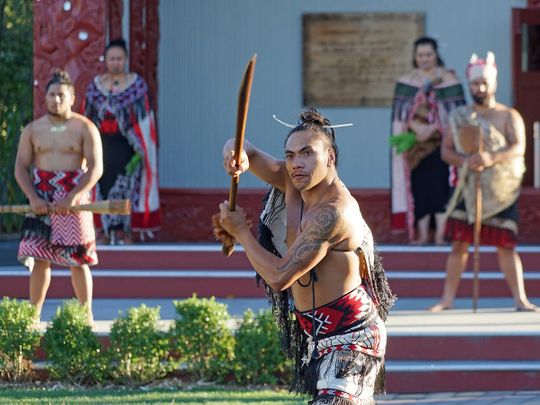
There was once a man called Tane Mahuta, known as the lord of the forest, in Maori folklore (the indigenous people of New Zealand).
Click start to play today’s Crossword and spot a Maori clue.
As the legend goes, Mahuta was the oldest of six siblings, and lived in darkness, enveloped by his sky father, Ranginui, and earth mother, Papa-tu-a-nuku. Tired of being smothered and closed off to the world, one day, Mahuta decided to push them apart, and in doing so, made the world of light – Te Ao Marama – that people live in today.
Stories like this, are called purakau or legends, and they abound in traditional Maori culture. As rich and complex as Maori traditions are, few of us know much about the indigenous people of New Zealand. Here are some fast facts to help you get to know them better:
1. The Haka
If there’s one thing you know about the Maori, it’s most likely the Haka – a compelling chant often seen at the beginning of New Zealand’s rugby games. Although the Haka is thought to be a ceremonial war dance, and it’s true that it was sometimes used for that purpose, there are actually many kinds of Haka dances used for different occasions – from funerals to motivation for the tribe. The dance represents a tribe’s pride, strength and unity, and includes movements like foot stomping, protrusion of the tongue and rhythmic body slapping, along with loud chants.
2. Origins
The first Maori people were settlers from East Polynesia, who arrived in New Zealand in waves of large, ocean-faring canoes in the 1300s. In terms of history, the Maori culture is one of the youngest in the world. It’s only 700 years old, as compared to Egypt and India, which are more than 5,000 years old.
3. Oral traditions
Before European settlers arrived in New Zealand, the Maori people did not have a written language. They spoke te reo (which translates to ‘the language’), which was the dominant language in the country until the 1860s, and still is an official language in New Zealand. Instead of written works, history was taught by the Maori through oral stories, or through elaborate carvings in wood. It’s why the Maori are considered to be extraordinary storytellers, and their heritage is full of folktales that inspire and awe.
4. Maori food
Some of the most flavourful, traditional meals in the Maori culture are slow-cooked underground. Hangi, for instance, is a feast cooked in an earth oven for several hours – it includes chicken, lamb, kai moana or seafood, and vegetables, and is placed on top of stones and then topped with dirt to trap the heat. Another quintessential Maori staple is rewena paraoa or potato bread, which is the result of a long period of fermentation. Sweet and slightly tangy, it’s wonderfully textured and a must-have Maori dish.
5. Maori welcome
Any time you visit a foreign land, it’s best to learn about the local etiquette. In the case of New Zealand’s indigenous people, the best way to experience their culture is to visit a Maori meeting ground. Called a marae, this meeting ground is where you’ll be welcomed by the tribe. But first, you must go through a powhiri, a challenge by a Maori warrior, which involves singing and chanting. The concept is that you must show that you come in peace. Although it may seem unnerving at first, it’s become a must-do Maori experience for travellers to New Zealand who are interested in learning about local customs.
Have you been to New Zealand and met Maori people? Play today’s Crossword and tell us at games@gulfnews.com.



